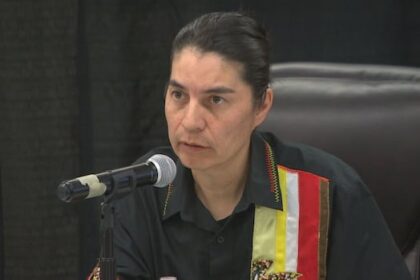Gathering influent data from composite samplers first step in pre-design studyPublished Jul 10, 20258 minute readMore air diffusers will be installed in the first and second treatment lagoons, on the left, at the regional sewage treatment plant in New Minas as work continues to solve a recurring odour problem. Photo by County of KingsArticle contentWork continues on getting a recurring odour problem at the regional sewage treatment plant in New Minas under control, and additional air diffusers are on the way.THIS CONTENT IS RESERVED FOR SUBSCRIBERS ONLY.Subscribe now to access this story and more:Unlimited access to the website and appExclusive access to premium content, newsletters and podcastsFull access to the e-Edition app, an electronic replica of the print edition that you can share, download and comment onEnjoy insights and behind-the-scenes analysis from our award-winning journalistsSupport local journalists and the next generation of journalistsSUBSCRIBE TO UNLOCK MORE ARTICLES.Subscribe or sign in to your account to continue your reading experience.Unlimited access to the website and appExclusive access to premium content, newsletters and podcastsFull access to the e-Edition app, an electronic replica of the print edition that you can share, download and comment onEnjoy insights and behind-the-scenes analysis from our award-winning journalistsSupport local journalists and the next generation of journalistsRegister to unlock more articles.Create an account or sign in to continue your reading experience.Access additional stories every monthShare your thoughts and join the conversation in our commenting communityGet email updates from your favourite authorsSign In or Create an AccountorArticle contentIn a July 8 update to Kings County council, Environmental Services manager Martin Kehoe said that in recent years, older, coarse air aerators have been replaced with a new, fine air diffuser system to promote greater oxygen transfer.Article contentArticle contentArticle contentKehoe said materials have been ordered to install an additional string of diffusers in the second lagoon. He said this would happen within a week or two, and municipal staff will install them.Article contentHe said they’ve received the engineered design for seven additional diffuser strings for the first lagoon. This is expected to take up to eight weeks, but Kehoe said they’re trying to expedite it.Article content“That upgrade will provide 20 per cent more oxygen to cell (lagoon) one at the current air flow,” Kehoe said.Article contentThe odour people are experiencing is caused by H2S (hydrogen sulphide) gas and perhaps, to a lesser extent, ammonia, resulting from a biological imbalance. In the past, dated and plugged aerators did not supply enough air to the treatment lagoons. A lack of oxygen is the leading reason for the odour problem, as the level of oxygen in the first and second of five lagoons is not in balance with the strength or load of incoming waste.Article contentArticle contentKehoe said people sometimes confuse this with meaning the treatment plant has exceeded its capacity, but that is not the case. The system is currently at about 50 per cent of design flow.Article contentArticle contentHe said engineering consultants have noted that biochemical oxygen demand (BOD) loading is within design specifications if current monitoring is capturing all the incoming BOD. A study currently underway that involves additional composite samplers will confirm system loading.Article contentKehoe said the first step in a pre-design study on the entire system tendered in February is the installation of composite samplers to gather influent data. Composite samplers were budgeted for 2025-2026 and consist of equipment that takes automated samples for analysis. He said municipal staff have been working with Town of Kentville employees on installation points.Article contentHe said four of the units have been ordered, and one has been delivered. The first one will be installed at the regional sewage treatment plant. The installation of the equipment is authorized under the Municipal Government Act, and data collection will be done over an extended period to develop trend information.Article contentProcess upgrades resulting from the study could include pre-screening solutions; possible conversion to alternative treatment technologies, post-treatment clarification or filtration, sludge management solutions, and overall sewage treatment facility optimization.Article content“There are a lot of different technologies,” Kehoe said. “I can’t say at this point where we’re going because we don’t know. That’s what our study is going to tell us.”Article contentThe study will encompass the type of incoming waste and projected growth and development in the service area. Kehoe said influent data and receiving water regulatory requirements are key components to the study. The installation of composite samplers and inline monitors will help ensure the accuracy of data.Article contentArticle contentProgress meetings with the regional sewage treatment system’s technical subcommittee will be held, and the study is to be completed by the spring of 2026.Article contentMore than 22,000 residents between Coldbrook and Greenwich, many commercial and industrial users, and institutions such as the Valley Regional Hospital use the regional sewage treatment system.Article contentArticle contentGovernance aspects under reviewArticle contentThe system is owned by the County of Kings and is operated as a partnership of the County of Kings, Town of Kentville, Village of New Minas, and PepsiCo.Article contentChief administrative officer Scott Conrod said municipal and village partners in the regional sewage treatment system have had success in the past with joint infrastructure applications. One recent example is the replacement of a conveyance line that runs along the Harvest Moon Trail from Kentville to the regional plant.Article contentArticle contentThe councils and village commission agreed to make one application for senior government funding, and that it would be their singular, No. 1 priority. This saw success, and he said this would likely be the model for future funding applications.Article content“Once this pre-design report is complete, then we will know what kind of cost structure we’re talking about,” Conrod said. “The best thing we can do is of course attract government money to lower the cost for our ratepayers.”Article contentHe said they are updating the technical subcommittee terms of reference and upcoming work, to dovetail with the pre-design report, which includes a review of system ownership, governance, financing, and a regulatory review leading to harmonized municipal bylaws, enforcement, and prosecution services.Article content County of Kings Environmental Services manager Martin Kehoe, top, right, presents an update to Kings County councillors on the regional sewage treatment plant in New Minas at the July monthly meeting. Shown at the bottom right of the image is one of the new composite samplers. Photo by County of Kings – YouTube ImageArticle contentIncreasing oxygen, new screen meshArticle contentThis year, air blowers supplying oxygen to the first and second lagoons were upgraded and reconfigured. Older, existing blowers now feed the first lagoon, while two new high efficiency blowers are dedicated to the second lagoon.Article content“During commissioning, we obviously made some adjustments,” Kehoe said. “The last important adjustment we made was June 16, and everything is running perfectly there.”Article contentDue to recent modifications to blowers in a second building supplying air to the third, fourth, and fifth lagoons, efficiency has been increased by 70 per cent and dissolved oxygen levels in these lagoons are increasing.Article contentMechanical mixers were added to the first and second lagoons this year. An oxygen-boosting compound is now being added to the treatment system as well. Kehoe said the plan is to continue dosing influent with the supplement. They continue to remove floating “mats” from the second lagoon.Article contentHe said smaller screen mesh has been received for drum screens, which is intended to address the amount of solid material entering the first lagoon. Staff have started installing the resized screens, and they’re already seeing positive results. Kehoe said all the new screens would all be installed by the following week.Article contentArticle contentCoun. Christina Sappington, who represents the New Minas area, asked if floating mats were caused by not having the appropriate screen mesh, and if the new screens would eliminate the problem.Article contentKehoe said the screens would definitely help, but floating mats are common in all lagoon-based treatment systems.Article contentHe said the plant retains wastewater for about 60 days from the time of inlet, through the five-lagoon treatment system, to the point of effluent discharge. He said each lagoon or cell is a different size, so the retention time differs for each.Article contentArticle contentDealing with biosolidsArticle contentSince 2021, more than 11,000 metric tonnes of sludge have been removed from the lagoons, not including the weight of materials being stored in geotubes.Article contentThe municipality has been measuring the buildup of biosolids in the lagoons with sonar technology. Sludge removal from the second lagoon is planned for the fall, as consultants have advised that the work should be done during cooler weather when dissolved oxygen is more prevalent. Kehoe said the second lagoon has about 4,500 cubic metres of sludge. The depth is uncertain, as it isn’t distributed uniformly.Article contentArticle contentThe third lagoon has about 6,000 cubic metres of sludge, while the fourth and fifth lagoons have about 2,800 cubic metres each.Article contentThe regional sewage treatment plant produces a Class B biosolid, which has to be transported to a New Brunswick facility for disposal due to current environmental regulations.Article content“Disposal will be revisited prior to the 2025 removal,” Kehoe said.Article contentArticle contentCouncillors have questionsArticle contentCoun. Bob Best said it seems that the second lagoon is currently causing most of the odour problem, and Kehoe agreed. Best said he understands that the consultants are advising to wait until fall to remove the sludge, but he is concerned the odour problem will continue until the arrival of cooler weather if they wait. He’d rather see it done now and “help the residents out in New Minas.”Article content“I just don’t understand why we don’t clean every one of them out,” Best said, pointing out that he knows it would cost a lot of money, but “I think the residents of New Minas deserve that.”Article contentDirector Brad Carrigan said one thing to consider in prioritizing sludge removal from the second lagoon is that when they did the previous desludging and aeration upgrades, the first lagoon was done last. During that time, they had to bypass the first lagoon, and the second lagoon, which has a fraction of the aeration, temporarily became the primary treatment lagoon.Article content“That’s why we’re seeing an abundance of sludge in cell two right now, and that’s why it’s our focus,” Carrigan said.Article contentHe said they plan to use the approved budget to desludge the second lagoon, and if there is money remaining after that, they would do as much additional sludge removal as possible from the remaining lagoons.Article contentSappington said the smell has not been constant as of late, and she believes her district is feeling “great relief.” She asked if there is a way to foresee when the odour will arise and take preventative action. Kehoe said having composite samplers installed will hopefully provide more information on BOD and allow them to make adjustments when necessary.Article contentArticle contentArticle contentBy the numbersArticle contentBetween the 2019-2020 to 2024-2025 fiscal years, the cost of upgrades to the regional sewage treatment plant, including sludge removal, totals $12,522,958. Chief administrative officer Scott Conrod recently told councillors that total will go up because they’re still in the process of closing out the numbers as of March 31, 2025.The total spent on sludge management during that timeframe is $4,649,240, including transportation and disposal costs.Another $4,625,000 is budgeted for capital improvements in 2025-2026, including $1,600,000 for sludge removal.The 2025-2026 regional sewer budget, including a capital budget of $810,500 and an operating budget of $1,483,400, totals $2,293,900. The $810,500 capital budget represents the current year’s portion of capital spending planned for 2025-2026, which totals $4,625,000.The County of Kings’ share is currently 17.7 per cent; the Town of Kentville, 48 per cent; Village of New Minas, 21.4 per cent; and PepsiCo, 12.9 per cent.Article content
More air diffusers coming as work to solve New Minas sewage stench progresses











